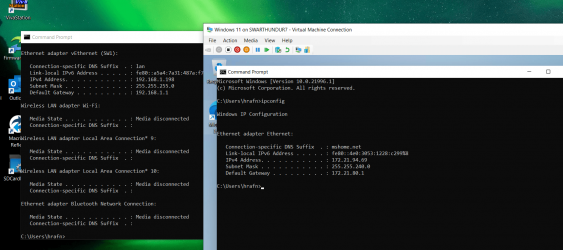- Local time
- 6:24 PM
- Posts
- 5,169
- Location
- Hafnarfjörður IS
- OS
- Windows XP,10,11 Linux (Fedora 42&43 pre-release,Arch Linux)
Hi there
@Kari
thanks for replies
I've given up for the day !!! Beer time I'm happy with performance etc but as always I get hosed up in Windows Networking
The VM has full internet access but can't see HOST t or any other machine on LAN -- looks like there's some "Nat" address using default switch. I created an external one to use the wired nic but can't delete the default one. For some machines on LAN I need SMB1 - done that, disabled firewall and allowed "connections to this computer". Still no joy.
Anyway leaving it for today as it was the TPM I was trying to test and that seems to be OK.
Appreciate though any ideas to get LAN and HOST access from the VM (on Gen 2 of course !!)

Cheers
jimbo
@Kari
thanks for replies
I've given up for the day !!! Beer time I'm happy with performance etc but as always I get hosed up in Windows Networking
The VM has full internet access but can't see HOST t or any other machine on LAN -- looks like there's some "Nat" address using default switch. I created an external one to use the wired nic but can't delete the default one. For some machines on LAN I need SMB1 - done that, disabled firewall and allowed "connections to this computer". Still no joy.
Anyway leaving it for today as it was the TPM I was trying to test and that seems to be OK.
Appreciate though any ideas to get LAN and HOST access from the VM (on Gen 2 of course !!)

Cheers
jimbo
My Computer
System One
-
- OS
- Windows XP,10,11 Linux (Fedora 42&43 pre-release,Arch Linux)
- Computer type
- PC/Desktop
- CPU
- 2 X Intel i7
- Screen Resolution
- 4KUHD X 2











